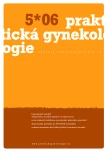Extrauterine pregnancy after IVF/TESE: casuistic
Authors:
MUDr. Vít Weinberger; doc. MUDr. Igor Crha, CSc.
Authors‘ workplace:
LF MU a FN Brno
; Gynekologicko-porodnická klinika
Published in:
Prakt Gyn 2006; 10(5): 180-181
Overview
Extrauterine pregnancy is a serious complication both in spontaneous pregnancy and in pregnancy achieved by methods of assisted reproduction. The rate of occurrence of ectopic pregnancy is estimated to be between 1 per 80 and 1 per 200 pregnancies [1]. Mortality has decreased from 4 ‰ to 0.5 ‰ since the 1970’s thanks to the introduction of new diagnostic methods [2]. Previous fallopian tube surgery, fallopian tube pathology and pelvic inflammatory disease are significant risk factors for extrauterine pregnancy. Hydrosalpinx is one of the most serious risk factors [3]. There are several hypotheses explaining the occurrence of extrauterine gravidity after embryo transfer: the transfer of the embryo directly to the fallopian tube, the influence of gravity, spontaneous migration of an embryo, the amount of cultivation medium, or high concentration of estradiol which moderates ciliary transport.
Key words:
extrauterine pregnancy – assisted reproduction – hydrosalpinx – pelvic inflammatory disease
Sources
1. Dubisson J, Morice P, De Gayfier A, Mouelhi T. Salpingectomy – the laparoscopic surgical choice for ectopic pregnancy. Hum Reprod 1996; 11: 1199–1203.
2. Fernandez H, Gervaise A. Ectopic pregnancies after infertility treatment: modern diagnosis and therapeutic strategy. Hum. Reprod Update 2004; 10: 503–513.
3. Magdolinič M, Lukáč V, Kubalík L. Heterotopic gravidity – successful laparoscopic management with persistent intrauterine gravidity. Gynekolog 1998; 2: 28–31.
4. Obstetricians NCO GF. Recommendations for clinical practices in ectopic pregnancy. J Gynecol Obstet Biol Reprod 2003; 32: 109–113.
5. Peršín J, Pospíchal J, Hanousek L. Úspěšná laparoskopická léčba heterotopické gravidity po spontánním otěhotnění. Gynekologie po promoci 2004; 6: 12–15.
6. Miklica J, Strmisková J, Pilka L. Donošené abdominální těhotenství – kasuistika. Gynekolog 1998; 6: 57–59.
7. Goldman G, Fisch B, Ovadia J, Tadir Y. Heterotopic pregnancy after reproductive tehnologies. Obstet Gynecol Surv 1992; 47: 217–221.
8. Maymon R, Shulman A. Controversies and problems in the current management of tubal pregnancy. Hum Reprod Update 1996; 2: 541–551.
9. Strandell A. Surgery in contemporary infertility. Current Women’s Reports 2003; 3: 367–374.
Labels
Paediatric gynaecology Gynaecology and obstetrics Reproduction medicineArticle was published in
Practical Gynecology

2006 Issue 5
Most read in this issue
- New options for treatment of disturbances of balance of vaginal environment
- Extrauterine pregnancy after IVF/TESE: casuistic
- New aspects in diagnosis and pathophysiology of polycystic ovarian syndrome
- The family Anamnesis as the Risk Factor of the Breast Cancer
